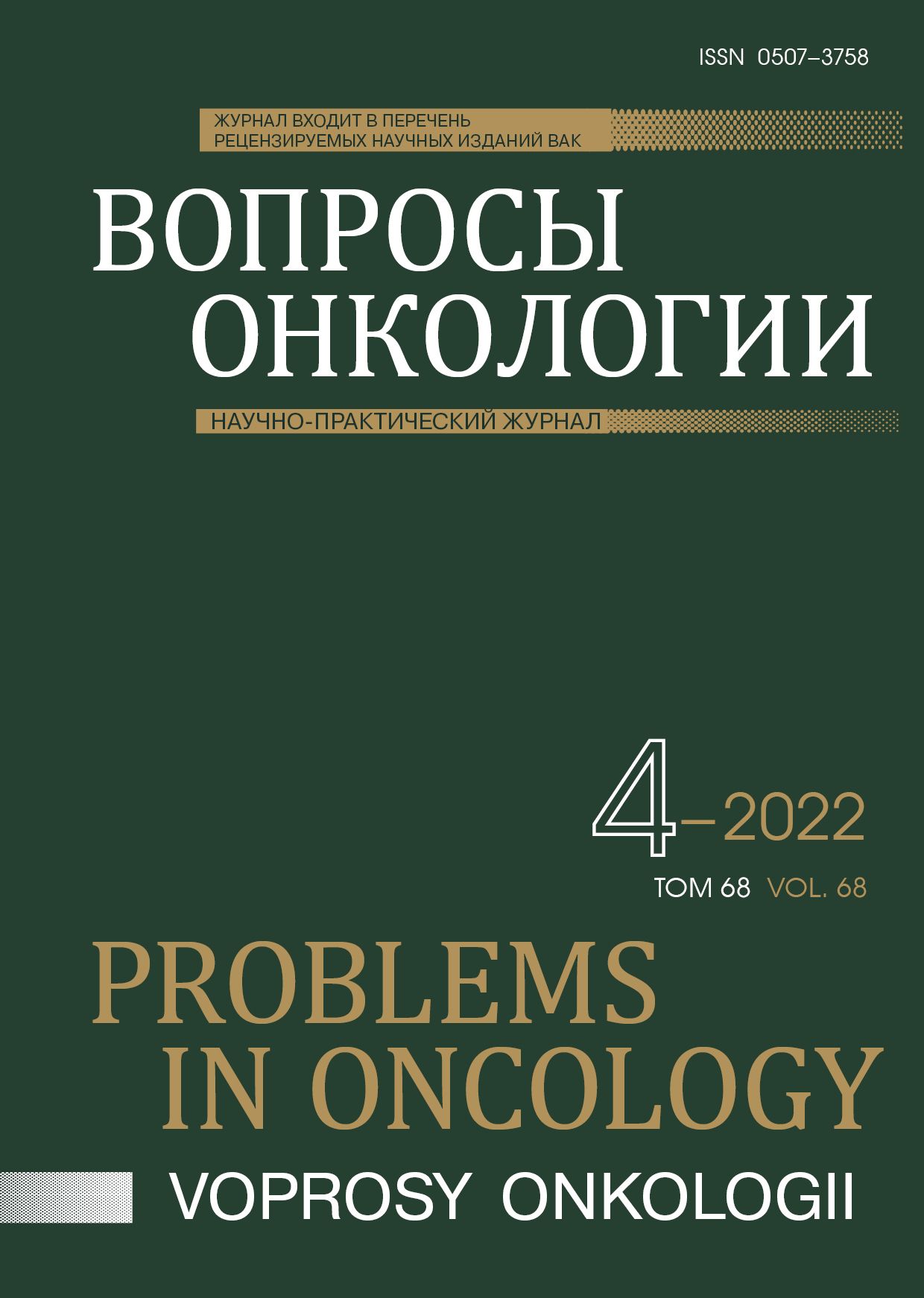Abstract
Material and methods. The study included 65 patients with papillary thyroid cancer T1-4N0-1M0. The comparison group was represented by 39 patients with benign thyroid pathology (22 patients with follicular adenoma and 17 patients with nodular goiter). The expression of the LC3B protein was assessed using the real-time PCR method, and the protein content was assessed by the Western blotting method. The BRAF-V600E mutation was determined using the Real-time-PCR-BRAF-V600E reagent kit.
Results of the investigation. An increase in the expression and content of the LC3B protein was found in the papillary thyroid cancer in 2.7 and 3.15 times compared with patients with benign tumor pathology. Patients with tumor size T3-4N0-1M0 showed a 1.6-fold increase in the LC3B protein content compared with patients with T1-2N0M0. The defeat of regional lymph nodes in patients with PCa was associated with an increase in the expression and content of LC3B by 2.0 and 2.4 times, respectively, compared with patients without metastases. An increase in protein expression and content was revealed by 2.5 and 1.7 times, respectively, in patients with the presence of the thyroid capsule invasion compared with patients without invasion. At the same time, a high content of autophagy protein was shown in the classical variant of the tumor, where the indicator was 2.8 times higher than in the follicular subtype.
Conclusion. An increase in the expression and content of the LC3B protein in the papillary thyroid cancers was revealed. The activation of autophagy plays a decisive role in oncogenesis and in the invasive and metastatic potential formation. The autophagy activation was revealed in the classic variant of papillary thyroid cancer. The association of the BRAF-V600E mutation with the expression and content of the LC3B protein has not been shown.
References
Abdullah MI, Junit SM, Ng KL et al. Papillary Thyroid Cancer: Genetic Alterations and Molecular Biomarker Investigations // Int. J. Med. Sci. 2019;16(3):450–460. doi:10.7150/ijms.29935
Gugnoni M, Sancisi V, Gandolfi G et. al. Cadherin-6 promotes EMT and cancer metastasis by restraining autophagy // Oncogene. 2017;36(5):667–677. doi:10.1038/onc.2016.237
Lewiński A, Adamczewski Z. Papillary thyroid carcinoma: a cancer with an extremely diverse genetic background and prognosis // Pol. Arch. Intern. Med. 2017;127(6):388–389. doi:10.20452/pamw.4058
Haugen BR, Alexander EK, Bible KC et al. 2015 American Thyroid Association Management Guidelines for Adult Patients with Thyroid Nodules and Differentiated Thyroid Cancer: The American Thyroid Association Guidelines Task Force on Thyroid Nodules and Differentiated Thyroid Cancer // Thyroid. 2016;26(1):1–133. doi:10.1089/thy.2015.0020
Araque KA, Gubbi S, Klubo-Gwiezdzinska J. Updates on the Management of Thyroid Cancer // Horm. Metab. Res. 2020;52(8):562–577. doi:10.1055/a-1089-7870
Spirina LV, Chizhevskaya SY, Kovaleva IV, Kondakova IV. The Association of the BRAF-V600E Mutation with the Expression of the Molecular Markers in the Primary Tumor and Metastatic Tissue in Papillary Thyroid Cancer. Asian Pac // J. Cancer Prev. 2021;22(7):2017–2024. doi:10.31557/APJCP.2021.22.7.2017
Spirina LV, Chizhevskaya SY, Kondakova IV. Molecular Profiling of Follicular Variant of Papillary Thyroid Cancer // Bull. Exp. Biol. Med. 2020;169(1):85–88. doi:10.1007/s10517-020-04830-9
Cunha LD, Yang M, Carter R et al. LC3-Associated Phagocytosis in Myeloid Cells Promotes Tumor Immune Tolerance // Cell. 2018;175(2):429–441.e16. doi:10.1016/j.cell.2018.08.061
Schaaf MB, Keulers TG, Vooijs MA, Rouschop KM. LC3/GABARAP family proteins: autophagy-(un)related functions // FASEB J. 2016;30(12):3961–3978. doi:10.1096/fj.201600698R
Yu X, Wu J, Wu Q, Sun S. Quantitative analysis of autophagy-related protein LC3B by quantum-dot-based molecular imaging // Methods Cell Biol. 2021;165:177–185. doi:10.1016/bs.mcb.2020.12.007
Satyavarapu EM, Das R, Mandal C et al. Autophagy-independent induction of LC3B through oxidative stress reveals its non-canonical role in anoikis of ovarian cancer cells // Cell Death Dis. 2018;9(10):934. doi:10.1038/s41419-018-0989-8
Gao P, Hao F, Dong X, Qiu Y. The role of autophagy and Beclin-1 in radiotherapy-induced apoptosis in thyroid carcinoma cells // Int. J. Clin. Exp. Pathol. 2019;12(3):885–892.
Schwertheim S, Theurer S, Jastrow H et al. New insights into intranuclear inclusions in thyroid carcinoma: Association with autophagy and with BRAFV600E mutation // PLoS One. 2019;14(12):e0226199. doi:10.1371/journal.pone.0226199
Kim HM, Kim ES, Koo JS. Expression of Autophagy-Related Proteins in Different Types of Thyroid Cancer // Int. J. Mol. Sci. 2017;18(3):540. doi:10.3390/ijms18030540
Xu Q, Gao S, Miao J. The relationship between autophagy-related genes and the staging and prognosis of thyroid cancer: a bioinformatics analysis // Gland. Surg. 2021;10(8):2511–2527. doi:10.21037/gs-21-480

This work is licensed under a Creative Commons Attribution-NonCommercial-NoDerivatives 4.0 International License.
© АННМО «Вопросы онкологии», Copyright (c) 2022
